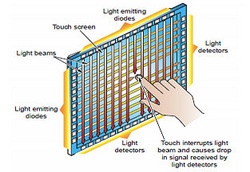A variety of different technologies have been built for touchscreens so far and they are continuously under development. Some of them are
· Resistive: The touch is registered by the pressure. Thus not only fingers but stylus and other objects
can be used.
· Capacitive: Only conductive materials are sensed on a conductive capacitive layer(s). Capacitive
touchscreens enable multi-touch interaction, so are widely used in the recent smartphones
like iPhones.
· Surface Acoustic Ultrasonic waves are passed over the panel and when the screen is touched,
Wave /SAW/ some portions of the waves are absorbed.
· Resistive: The touch is registered by the pressure. Thus not only fingers but stylus and other objects
can be used.
· Capacitive: Only conductive materials are sensed on a conductive capacitive layer(s). Capacitive
touchscreens enable multi-touch interaction, so are widely used in the recent smartphones
like iPhones.
· Surface Acoustic Ultrasonic waves are passed over the panel and when the screen is touched,
Wave /SAW/ some portions of the waves are absorbed.

· Infrared This is also called light beam interruption technology.
A lot of LED(Light Emitting Diodes) are located along the
X Y direction. They radiate uniform infrared light beams
and the touch is detected by the interruption in the light.
A lot of LED(Light Emitting Diodes) are located along the
X Y direction. They radiate uniform infrared light beams
and the touch is detected by the interruption in the light.

Touch Frames
· Optical Imaging: It is one of the modern technologies. It uses background light
and image sensing cameras. The cameras are located on the
edges of the screen and when an object is approached, the
shadow in the light is detected and located by them.
and image sensing cameras. The cameras are located on the
edges of the screen and when an object is approached, the
shadow in the light is detected and located by them.
Out of these, the most common are the resistive and the capacitive touchscreens. In the market, there always arises the question of which one of these two is better. According to some experts’ point of view, both of them have their goods and bads.
Resistive touchscreens are simpler and cheaper to make and they perform reasonably good sensing. Because they sense the pressure of the touch, stylus and other objects can be used. That makes it a good choice for phones, tablets with stylus and card readers at the grocery stores, banks and so on. The capacitive touchscreens, on the other hand, offer better optical features and easier and more extensive multi-touch interaction. Therefore they are being used more on high feature phones like iPhone and also are used for iPads too. However, they are a little more expensive to make and they can only sense conductive materials, but capacitive gloves and styli have been designed and are already in market. Bellow is the comparison chart between the capacitive and resistive touchscreens by Microchip company.
A short video bellow here also can give you a reasonably good comparison between the two.
